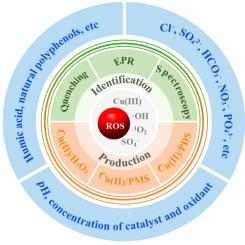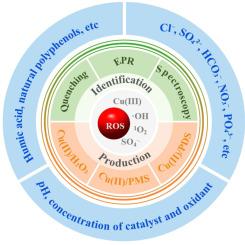Cu(II)-mediated homogeneous advanced oxidation processes: Characteristics, identification, and environmental applications of Cu(III)
IF 12.4
1区 环境科学与生态学
Q1 ENGINEERING, ENVIRONMENTAL
引用次数: 0
Abstract
In the field of environmental remediation, significant attention has been directed toward degradation-efficient and condition-mild wastewater treatment technologies. Cu(II)-mediated homogeneous advanced oxidation processes (AOPs) have emerged as promising technologies, given the ubiquity of Cu(II) in actual wastewater. An in-depth understanding of these processes is essential for the further development. In this review, recent advances on Cu(II)-mediated H2O2/peroxymonosulfate/peroxydisulfate catalytic systems are critically reviewed, with an emphasis on the characteristics, identification and environmental applications of trivalent copper (Cu(III)). Unlike conventional reactive oxygen species (e.g., ·OH or SO4·−), Cu(III) exhibits exceptional redox properties, including high selectivity and robust anti-interference capacity, enabling precise pollutant degradation even in complex wastewater matrices. Finally, the drawbacks and challenges of current techniques for Cu(III) identification and application are discussed, along with the future perspectives in the development of identification and implication strategies for Cu(III). This review is anticipated to offer fundamental insights into the characteristics and applications of Cu(III).


Cu(II)介导的均相高级氧化过程:Cu(III)的特性、鉴定和环境应用
在环境修复领域,高效降解和条件温和的废水处理技术已成为人们关注的焦点。考虑到Cu(II)在实际废水中的普遍存在,Cu(II)介导的均相高级氧化工艺(AOPs)已成为一种有前途的技术。深入了解这些过程对进一步发展至关重要。本文综述了Cu(II)介导的H2O2/过氧单硫酸根/过氧二硫酸根催化体系的最新进展,重点介绍了三价铜(Cu(III))的特性、鉴定和环境应用。与传统的活性氧(如·OH或SO4·−)不同,Cu(III)表现出优异的氧化还原性能,包括高选择性和强大的抗干扰能力,即使在复杂的废水基质中也能精确地降解污染物。最后,讨论了当前Cu(III)鉴定和应用技术的缺陷和挑战,以及Cu(III)鉴定和暗示策略发展的未来前景。本文综述有望为Cu(III)的特性和应用提供基础性的见解。
本文章由计算机程序翻译,如有差异,请以英文原文为准。
求助全文
约1分钟内获得全文
求助全文
来源期刊

Water Research
环境科学-工程:环境
CiteScore
20.80
自引率
9.40%
发文量
1307
审稿时长
38 days
期刊介绍:
Water Research, along with its open access companion journal Water Research X, serves as a platform for publishing original research papers covering various aspects of the science and technology related to the anthropogenic water cycle, water quality, and its management worldwide. The audience targeted by the journal comprises biologists, chemical engineers, chemists, civil engineers, environmental engineers, limnologists, and microbiologists. The scope of the journal include:
•Treatment processes for water and wastewaters (municipal, agricultural, industrial, and on-site treatment), including resource recovery and residuals management;
•Urban hydrology including sewer systems, stormwater management, and green infrastructure;
•Drinking water treatment and distribution;
•Potable and non-potable water reuse;
•Sanitation, public health, and risk assessment;
•Anaerobic digestion, solid and hazardous waste management, including source characterization and the effects and control of leachates and gaseous emissions;
•Contaminants (chemical, microbial, anthropogenic particles such as nanoparticles or microplastics) and related water quality sensing, monitoring, fate, and assessment;
•Anthropogenic impacts on inland, tidal, coastal and urban waters, focusing on surface and ground waters, and point and non-point sources of pollution;
•Environmental restoration, linked to surface water, groundwater and groundwater remediation;
•Analysis of the interfaces between sediments and water, and between water and atmosphere, focusing specifically on anthropogenic impacts;
•Mathematical modelling, systems analysis, machine learning, and beneficial use of big data related to the anthropogenic water cycle;
•Socio-economic, policy, and regulations studies.
 求助内容:
求助内容: 应助结果提醒方式:
应助结果提醒方式:


